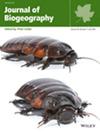Forest Microclimate as a Driver of Epiphytic Bryophyte Diversity Along a Subtropical Elevational Gradient
Abstract
Aim
Considering the importance of microclimate in maintaining the diversity of epiphytic bryophytes, we investigated epiphytic bryophytes along an elevational gradient in the subtropical forest of eastern China to unravel the diversity patterns of epiphytic liverworts and mosses along the elevational gradients and the roles of forest microclimates, topographic variables and host plant composition attributes in shaping these elevational diversity patterns.
Location
Tianmushan National Nature Reserve, Zhejiang, China.
Taxon
Epiphytic bryophytes.
Methods
Species diversity patterns of liverworts and mosses were compared based on an inventory of 16 plots along an elevational gradient from 367 to 1470 m. In situ microclimatic data of air temperature and moisture were collected under constant monitoring for over 3 years. Spatial linear models and structural equation models were used to assess the relative roles of the environmental variables in shaping the patterns of species diversity along elevation.
Results
We found that epiphytic liverwort and moss richness showed different elevational patterns; overall richness patterns of epiphytic bryophytes were largely driven by mosses. Epiphytic mosses exhibited a decline, followed by a hump-shaped pattern of species richness with increasing elevation, while epiphytic liverworts showed a mid-elevation plateau with a richness maximum between 800 and 1300 m. Forest microclimate, topography and host plant composition attributes influence epiphytic moss and liverwort patterns differently and interact in a complex way. Overall, species richness of epiphytic liverworts was most strongly affected by microclimate (mean annual air temperature of growing season) and of epiphytic mosses richness by topography (slope). Further, epiphytic liverwort species richness was more influenced by temperature than moisture.
Main Conclusions
This study highlights the importance of collecting climatic factors at a fine scale (microhabitats) for understanding the patterns and drivers of bryophyte diversity. Further, our findings demonstrate the differences between liverworts and mosses in terms of their response to different environments in the forest ecosystem.

 求助内容:
求助内容: 应助结果提醒方式:
应助结果提醒方式:


